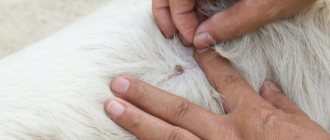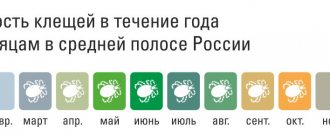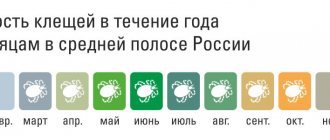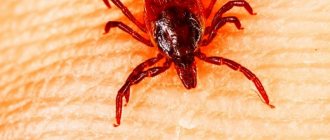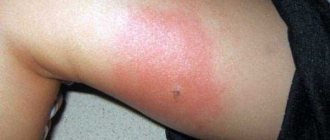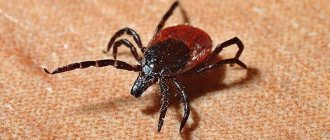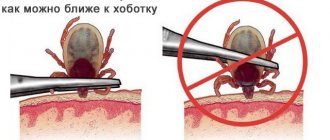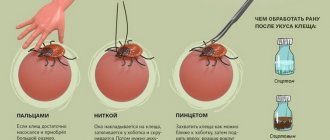An arthropod bite in itself cannot seriously harm a pet’s health. If a tick attaches itself to a dog, inflammation, itching, or a small abscess may occur at the site of the bite. But infectious diseases carried by parasites can cause health problems and cause the death of a dog. Therefore, you should carefully examine your pet after each walk and, if you find a tick, seek help from specialists.
Types of ticks and their level of danger
A tick is an arthropod arachnid that leads a parasitic lifestyle. It is often mistakenly classified as an insect. It's quite easy to remember their differences. Arachnids have an additional, fourth pair of limbs.
The arthropod occurs in 4 forms: egg, larva, nymph and adult. Only eggs are not adapted to self-feeding, so all other forms are dangerous for warm-blooded individuals and humans.
All known species are divided into 3 large groups:
- External
. They attach themselves to the outside of the body and are among the most dangerous. This group includes ixodic and encephalitic individuals that carry piroplasmosis, borreliosis and encephalitis.
- Subcutaneous
. They parasitize under the skin, penetrating into it from the external environment. Infection occurs locally or generalized, that is, it covers a certain area or the entire body of the animal.
- Intradermal
. They live inside the body in a dormant form from the moment of birth. They pose a danger when certain factors occur.
Ixodid ticks are held on to the fur by tiny spines covering 4 pairs of limbs. Their oval body is covered with a dark chitinous shell. While feeding, they cut the skin with teeth on their proboscis and inject an anesthetic. The body of the parasite, filled with blood, increases 3 times.
Subcutaneous include the white or yellowish-white sarcoptes scabiei, which causes sarcoptic mange, and the dirty gray notoedres, which causes notoedrosis (scabies). The size of these bloodsuckers does not exceed 0.45 mm.
The smallest representative is the subcutaneous demodex canis, which is light gray in color. The length of its cigar-shaped body is 0.2-0.3 mm. The parasite lives in the sebaceous glands and hair follicles.
How to do a smear for piroplasmosis?
Capillary blood is collected from the animal’s ear as follows:
- shave the hair from the inside of the ear
- treat the skin with a disinfectant
- make a small skin incision
- a drop of blood is placed on a glass slide
- form a smear
- the preparation is dried and stained with Diff-Quick
- cover with a cover glass
- study the sample using a microscope.
IMPORTANT: The results of this analysis can be obtained immediately, at the first appointment.
The results of the analysis for piroplasmosis can be obtained at the first appointment
What diseases do ticks carry?
If a dog is bitten by an uninfected tick, then its health is not in danger. But in cases where the parasite is a carrier of the infection, things become more serious.
A tick can carry not only the well-known borreliosis and encephalitis, but also other, less dangerous, but still unpleasant diseases.
Encephalitis
This is an inflammation of the brain, which often ends in the death of the infected person. The success of treatment depends on the strength of the immune system, as well as on the promptness of taking first measures. Symptoms of encephalitis in dogs include paralysis and convulsions, lethargy, loss of consciousness, and headache.
Borreliosis
The second name is Lyme disease. A dangerous neurological disease can cause complete or partial paralysis, as well as arthritis. The first signs are inflammation of the joints and, consequently, lameness. The dog is in pain, and this manifests itself in lethargy, decreased activity, and sometimes unfriendly behavior or whining.
Piroplasmosis (babesiosis)
Quite often, dogs avoid the first two dangerous diseases when bitten by a tick, but become infected with piroplasmosis. This disease is typical only for quadrupeds.
The first manifestations are lethargy, shortness of breath, fever, vomiting or diarrhea, a little later jaundice is detected, the dog may experience pain in different parts of the body.
Bartonellosis
An extremely unpleasant disease that can be fatal if it is asymptomatic. But most often it manifests itself with the following symptoms:
- apathy, loss of appetite;
- temperature increase;
- inflammation - from external to internal;
- sudden weight loss;
- disruption of the heart;
- capillary hemorrhages;
- in severe cases - pulmonary edema.
With timely treatment, the disease can be completely defeated.
Ehrlichiosis
This is a hematological disease (imbalance of blood cells) that manifests itself in a high fever. It is also accompanied by other severe symptoms depending on the variety: hemorrhages and bleeding, fever, cramps, inflammation, etc.
Hepatozoonosis
The insidiousness of this disease lies in the fact that an animal can become a carrier without manifestations. As soon as his immunity weakens, hepatozoonosis will manifest itself with fever and discharge from the eyes. They may be accompanied by severe pain in muscles and joints.
What to feed your pet with piroplasmosis
If your pet doesn't want to eat, don't force food in. To maintain strength, give your pet food often - take liquid (you can use lean broth) into a large syringe without a needle and squeeze it into the mouth. Don't give me milk!
The diet should be aimed at increasing hemoglobin, immunity, and vitality. If you still have an appetite, give pureed lean meat (turkey, beef, lamb), add a little vegetable oil. Check with your veterinarian whether you can give porridge (rice, buckwheat, wheat) with meat. If yes, cook the cereal and make a puree. If the dog refuses porridge, do not give it.
As an option, you can buy ready-made dietary food intended for animals with diseased kidneys and liver. The dry must be soaked until it becomes a paste, the canned food must be mixed with warm water. The food should not be cold.
Can a person become infected?
Not only four-legged animals, but also humans can become infected from an arachnid. The list of the most dangerous diseases includes encephalitis and Lyme disease (borreliosis). They cause irreversible neurological changes that can only be treated in the early stages.
“
It should be noted that the diseases mentioned are dangerous for people, but they are not transmitted from dogs to humans. The risk only arises when an infected tick brought by a dog bites a person. Therefore, anti-tick treatment of your pet should be carried out in completely covered clothing.
Rare types of encephalitis can be transmitted through saliva and other secretions of an animal. But usually tick-borne encephalitis is contracted only from a parasite bite. Borreliosis is not transmitted at all from animals to humans.
A less dangerous disease, ehrlichiosis, can also occur in humans and dogs when bitten by a tick, but they cannot become infected from each other.
But the scabies mite easily travels through the air between all mammals. Therefore, it is recommended to isolate a dog infected with a subcutaneous tick from other residents, and treatment measures should be carried out wearing gloves and special clothing.
How does babesiosis become infected?
Ticks can be called both the main and intermediate hosts of protozoa. They become infected from rats and other small rodents that are not susceptible to Babesia.
In the body of ticks, Babesia reproduce both sexually and asexually. They pass through the stage from larvae to imago, and are transmitted through eggs to the next generation of arthropods. Ticks, to which the infection is inherited, become completely infected. In particular, Babesia enter the salivary glands.
When a tick bites through an animal's skin, the protozoa enter the bloodstream with saliva. They immediately invade red blood cells and begin to multiply, destroying red cells. When red blood cells rupture, new parasites emerge and infect other blood cells. Therefore, ticks are not the only route of infection.
Infection can also occur:
- when receiving blood transfusion from a sick animal;
- from bitch to litter;
- with bites (for example, during a fight).
Symptoms and signs of a bite
Most often, a tick bite in a dog causes burning and itching. More severe symptoms are explained by an infection transmitted through the parasite's saliva or a weak immune system. The resulting reactions are divided into 3 groups:
- Are common
. Problems with coordination arise, bowel movements are disrupted, activity and appetite decrease. The dog is constantly itching.
- Local
. Symptoms of a tick bite in a dog include swelling, redness or purulent inflammation, itching and pain at the site of the insect's attachment, and an increase in local temperature.
- Neurotoxic
. After a tick bite, a dog develops “tick paralysis.” The hind and front legs begin to fail, the swallowing reflex is disrupted, shortness of breath appears, and the volume and audibility of barking decreases. Without timely assistance, the animal dies from suffocation due to spasm of the larynx.
The signs that appear depend on the type of arachnid; you can see them in more detail in the example table.
| View | Symptoms |
| External |
|
| Subcutaneous |
|
| Intradermal |
|
“ The most dangerous signs of a tick bite in a dog are a change in the color of the urine and the appearance of seizures.
The first sign indicates piroplasmosis, and the second sign indicates encephalitis. If an animal becomes infected with one of these diseases, it must receive medical attention within 2-5 days. Otherwise it dies.
If you didn’t immediately notice that your dog has a tick
It happens that a tick bite goes unnoticed by the owner. You can find a crushed parasite on the floor that has drunk blood and fallen off on its own. Sometimes the parasite is detected on days 5–7 . At this time, the tick looks like an inflated balloon.
It is not difficult to remove such an insect. It is enough to grab it with your clubs closer to the head and pull. Most likely, he can easily detach himself from the dog. If the pet feels well and does not show anxiety, then there is no reason to panic. It is necessary to observe behavior and condition.
Unfortunately, some diseases transmitted by arthropod arachnid parasites are hidden and have a long incubation period.
To avoid complications, you need to take your dog to see a veterinarian and submit the tick to a laboratory for analysis.
Warning symptoms and signs
If a tick has bitten into your dog, you should pay attention to the symptoms that are typical of infectious diseases.
Groups of symptoms:
- General : decreased or lack of appetite, anxiety, lethargy, itching, diarrhea, vomiting, decreased activity.
- Local : pain in the area of the parasite bite, hyperemia of the mucous membranes and skin, swelling, purulent discharge from the nose and eyes.
- Neurotoxic : impaired coordination and swallowing reflex, shortness of breath, limb failure, pulmonary edema.
General symptoms depend on the dog’s immunity, the disease, the type of tick, the general condition of the pet’s body and associated complications. You should immediately seek help if your dog develops one or more symptoms. Since some diseases occur rapidly and can lead to the death of a pet.
Dangerous symptoms:
- convulsions, paralysis;
- temperature increase;
- diarrhea, vomiting (bile);
- pallor or yellowness of mucous membranes;
- heart failure;
- slower reactions;
- mood swings from passivity to aggression;
- coffee-colored urine.
It is important to remember that in puppies, old, weakened and decorative (small) animals, the disease progresses rapidly, and the changes are often irreversible. Therefore, it is necessary to contact the clinic immediately after detecting the parasite.
You should be aware that if your dog has any symptoms and the parasite is not detected, the disease may be caused by a subcutaneous tick. Like ixodid arachnids, this type of parasite is capable of transmitting dangerous infectious diseases. And also, one should not exclude the possibility that the tick has already fallen off and safely disappeared into the nearest park.
Causes of infection and possible consequences
External and subcutaneous mites are transmitted by contact with an infected mammal or contaminated items. The risk group includes puppies, elderly dogs, animals with chronic diseases and purebred pets with a good pedigree. The consequences of a tick bite in dogs from this group are always more severe.
Intradermal arachnids that cause demodicosis become pathogenic when the immune system is sharply weakened. This occurs when the following factors
:
- pregnancy and childbirth;
- stress and mental disorders;
- estrus;
- docking of ears or tail;
- recent surgeries;
- change of teeth;
- long-term use of antibiotics;
- poor quality nutrition;
- hypothermia or overheating of the body;
- infectious and autoimmune diseases.
Demodex canis is often seen in German Shepherds, Great Danes, Boxers, Afghan Hounds, English Bulldogs, Collies, Doberman Pinschers, Dachshunds, Bobtails, Cocker Spaniels and Chihuahuas. The disease is transmitted from mother to puppies, but is not considered dangerous to other animals or humans.
Demodicosis manifests itself in 2 forms: scaly and pustular. In the first case, redness and cracks appear on the skin, in the second - pustules and ulcers.
Symptoms of the disease are observed only in one place, but if left untreated, they spread to neighboring areas. The resulting wounds attract pathogenic microorganisms. Possible complications include sepsis from a secondary infection, which reduces the chances of recovery by up to 50%.
“ Symptoms of a tick bite in a small breed dog are more pronounced than in larger animals.
The effects of a neurotoxic reaction develop more quickly in small dogs. If an encephalitis tick has bitten a Spitz or Toy Terrier, then immediately seek help from the nearest veterinary clinic.
Other dangerous consequences include the following diseases: ehrlichiosis, hepatozoonosis and bartonellosis. They can be recognized by a delayed reaction, the appearance of purulent discharge from the eyes or bleeding from the nose. All these signs appear in late stages and are difficult to treat.
Veterinarian answers to key questions
Very often, when faced with a bite problem, owners are not aware of the consequences. To understand the situation, you need to study all available information or seek advice from specialists.
Can a dog die from a tick bite?
A dog will not die from a simple bite . You should also know that not all ticks are carriers of diseases. In addition, infection takes time, and a parasite detected and removed in time will not have time to infect the dog.
But if time is lost, and the tick has managed to suck, you should show the dog to a doctor. If all this is left unchanged, then the cause of death can be dangerous diseases.
The dog still has a tick head, what to do?
If such a situation arises, you can seek help from a clinic or wait for natural rejection of the parasite. If the dog is healthy, the body itself will expel the foreign body. Most likely, swelling and inflammation will develop at the site of the bite. If the process is not complicated by other symptoms, the head will come out through the wound along with pus and ichor. In case of complications, you must contact the clinic.
How to understand that a tick was infectious
Infected and uninfected ticks have no external differences. It is possible to find out whether the parasite is a carrier only through laboratory tests. To do this, you must submit a live tick for analysis no later than 2 days.
If for some reason the tick remains in the dog, you can bring your pet to an appointment with a veterinarian. Specialists will remove the tick and send it for analysis.
How dangerous is it if a tick bites a pregnant dog?
After a bite, you should not wait for symptoms to appear. You must contact the clinic immediately. This will help maintain the health of the mother and future offspring. It is important to remember that diseases will primarily affect the health of embryos and can lead to the death of unborn children and the mother.
Do dogs get tick vaccinations?
Vaccinations do not protect your dog from ticks. The action of the drugs is aimed at protecting the body from diseases carried by parasites. For the purpose of protection and prevention, you can vaccinate your pet against tick-borne encephalitis and piroplasmosis (Eurikan Piro, Piro Stop).
What should the owner do?
A tick bite on a dog is always accompanied by licking of the wounds left by the parasite's proboscis. If you are sure or at least suspect an infection, contact your veterinarian.
Dosages of acaricidal drugs used to combat arachnids are selected individually. Self-treatment is unacceptable. Most animals left without qualified help do not survive.
First aid and diagnostics
Most often, parasites attack weakly protected areas: the hind and front legs, armpits, ears, groin and abdomen. A bloodsucker that has eaten its meal grows to the size of a large bean, so it is easy to notice upon detailed examination.
If you are providing first aid to your dog for a tick bite, wear protective gloves. Do not forget that small arachnids are dangerous not only for your four-legged pet, but also for its owner.
For safe removal, a set of Tick Twister tweezers will be useful. This tool removes the attached parasite with minimal risk. If you don’t have tweezers at hand, you’ll have to do it the old fashioned way. For this you will need:
- Fingers
. Everyone has it, so there shouldn't be any problems. Wrap them in a clean cloth or bandage. Grasp the body of the arthropod in the place where it is attached and twist it in a certain direction. Move clockwise or counterclockwise without changing the original order.
- Tweezers from a manicure set
. Grab the body of the parasite where it enters the skin, placing the tips of the instrument horizontally. Without loosening your grip, begin to twirl the tweezers. Avoid direct upward pulls. After successful extraction, treat the wound with an antiseptic.
If a tick has bitten a dog, then it can only be helped with the tools listed above.
Kerosene, oil or gasoline form an impenetrable film or caustic vapor. The arachnid dies from lack of oxygen or poisoning immediately after transmission of the infection. Thread loops are also prohibited. Due to the tension, the tick often loses its head, so it has to be searched for and removed with a heated needle.
“Within 2 days, the insect can be transferred to the clinic for detailed diagnosis. For this, a tightly closed jar with wet cotton wool inside is useful.
If you do not have the specified time, burn it, scald it with boiling water, or simply crush the insect between several layers of thick paper.
After first aid, rush to the veterinarian for diagnosis. Immediately after a tick bite, your dog should not be given antipruritic medications. They will distort the clinical picture and prevent the correct diagnosis. Relieving itching with the help of drugs is only permissible if the victim cannot be taken to the clinic on the day of infection.
At the veterinary clinic, a visual examination and medical history is taken. After becoming familiar with the individual factors that can influence the development of the disease, the doctor takes a blood and urine test.
Their study determines the presence of toxins released during the life of parasites. Scraping is used to identify their type, and ultrasound and x-rays are used to track internal pathologies.
The duration of treatment depends on the type of disease, degree and duration of infection.
Features of treatment
The recovery period takes from 4 to 8 weeks. Therapy is based on detoxifying the body and eliminating secondary infections. Drug treatment includes taking:
- antihistamines that relieve itching;
- minerals and vitamins that stimulate the immune system;
- acaricidal drugs that act directly on parasites;
- hemostatic agents;
- diuretics that remove accumulated toxins;
- hepatoprotectors that ease the load on the liver.
A tick bite on a dog, accompanied by severe intoxication, requires a mandatory blood transfusion.
When handling a pet infected with notoedrosis or sarcoptic mange, you will need protective gloves. After handling this medication, wash your hands thoroughly. Acaricidal drops are always instilled into both ears, even when only one is affected.
“If affected by demodicosis, the pet is rejected from breeding and sterilized.
Regardless of the form of the disease, the dog is cut and treated with peroxide. After cleansing, wash it with antiseborrheic shampoo. The scheme for subsequent treatment of ulcers and suppurations is agreed with the veterinarian.
This disease is characterized by relapses. Visit the veterinary clinic for preventative purposes at least 2 times a year, even after recovery.
In addition to drug treatment, it is necessary to limit physical activity. Daily walks at a slow pace are welcome, but intense training will have to be abandoned until complete recovery.
“ During treatment, a gentle diet is recommended. Fatty and heavy foods are prohibited. The diet is based on oatmeal, chicken fillet and beef tenderloin. All food should be at room temperature. Avoid reheating. Familiar delicacies are replaced with rosehip decoction.
Of all the diseases considered, only the extreme stage of encephalitis, accompanied by extensive inflammation of brain tissue, cannot be treated. The only humane solution to such an infection is euthanasia.
The dog was bitten by a tick, what to do next: first aid
Beginners, when faced with the problem for the first time, are lost and do not know what to do if the dog is bitten by ticks. First you need to calm down and examine your pet. It is possible that there are other arachnid parasites on the animal’s body. Ticks typically choose soft and easily accessible areas such as the neck, abdomen, inner thighs, armpits, ears and head. Then you need to remove the parasite and provide first aid to your pet.
Also read an important article on the topic: “Protecting your pet from ticks: a review of the best remedies.”
How to remove a tick yourself
Do not pull the tick by the abdomen, use thread or tweezers with sharp edges, or treat the bite site with oil or kerosene. The abdomen may tear, making it more difficult to remove the parasite. Treatment with oils and kerosene will lead to the death of the tick, but during the time it remains in the animal’s body, the parasite can inject an infection into the wound. These methods can harm not only the tick, but also the pet.
Before removing a tick, you need to put on gloves, prepare a tool, and a jar for the parasite. Special twisting tools or tweezers with round edges are best. If you don't have the right tool at hand, you can pull the tick out with your fingers.
Stages:
- You need to move the fur apart or trim it a little in the area of the bite.
- Treat the puncture site with alcohol or other antiseptic.
- It is necessary to grab the tick as close to the head as possible.
- You cannot tug or pull the parasite. It is necessary to unscrew the tick from the wound.
- The parasite is placed in an airtight jar.
Pets usually react poorly to the procedure. But if the dog shows anxiety, it needs to be calmed or restrained.
We removed a tick from a dog, what to do next?
The wound after a tick is treated with alcohol-containing or antiseptic agents. The tick can be crushed, burned, or thrown away in an airtight jar.
But if tests are planned, the tick must be preserved. Using a laboratory test, you can find out whether the tick was a carrier of a dangerous disease.
When to go to the vet
Your pet should be shown to a doctor if:
- Unfavorable epizootological situation in the place of residence.
- The dog is covered in ticks. Even in the absence of hidden diseases, numerous bites can be harmful to health.
- The dog exhibited alarming symptoms that could be the cause of a dangerous disease. Such as vomiting, diarrhea, weakness, depression, shortness of breath, etc.
It is not recommended to take medications before visiting the veterinarian. They can blur symptoms and make diagnosis difficult.
Prevention recommendations
Infection cannot be ruled out, but the risk can always be reduced. Important for your pet's health
:
- Don't neglect vaccination. Passive immunity lasts for six months. Even if infected, a vaccinated individual will tolerate the disease more easily.
- Limit communication with unfamiliar four-legged animals. Most often, stray dogs and wild animals become carriers. And playing with a fluffy squirrel is fraught not only with invasion, but also with rabies.
- Carefully inspect hard-to-reach places on your body after each walk. The speed at which the first symptoms appear varies from person to person. If no signs are found, then repeat the skin examination after a couple of hours.
- Control your diet. A proper and balanced diet is the key to a strong immune system.
- Contact a veterinary clinic for help with any questions or suspicions. It is better to make mistakes several times than to lose your beloved dog due to carelessness.
- Use anti-tick agents during periods of increased parasite activity: from April to October. If the dog has long hair or profuse sweating, which requires frequent washing, increase the recommended dosage of medications.
- Avoid mating if infestations are detected. Feel free to ask for information from the second owner.
- Sterilize after infection with subcutaneous parasites. Not only future offspring can suffer, but also the bitch herself. Relapse of the disease occurs against the background of any hormonal changes.
Antiparasitic agents include vaccines, collars, sprays and drops. Each of them has its own advantages and disadvantages.
Vaccine
Giving your pet a vaccine will reduce the likelihood of infection. The most popular include “Nobivak Pro” and “Pirodog”. These vaccines protect against piroplasmosis. Only healthy animals are allowed to be vaccinated. Vaccination after infection is pointless.
To consolidate the result, a second vaccination is given 1 month after the first vaccination. All subsequent ones are done once every six months independently or in a veterinary clinic.
Collars
Collars last for more than six months, but often cause local allergic reactions. If your pet's hair falls out, you will have to abandon the collar in favor of drops or sprays.
“ Due to the ingredients included, the collars are not suitable for nursing or pregnant women, puppies under 2 months of age, or animals with chronic illnesses.
The smell emitted by the product repels insects and remains on the body for some time even after removal. According to the method of exposure, they are chemical, biological and ultrasonic. The first two are repelled by the smell of chemicals or essential oils, and the last one is repelled by ultrasound, which is detected only by arachnids. An ultrasonic collar is more expensive than its analogues, but is considered safer.
Treatment of a pet at home
You should not self-medicate at home until a diagnosis is made. All medications and procedures must be prescribed by the attending physician after examination and tests.
Very often, the period of treatment and rehabilitation takes several months. The time depends on the type and nature of the disease, the selected therapy and the sequence of treatment. If you decide to treat your pet at home, you must follow the doctor’s recommendations and complete the full course. This is very important, since many diseases can “fall asleep” for a while, and then manifest themselves with a vengeance.
List of drugs
Typically, therapy is aimed at suppressing the disease, secondary symptoms and complications. And also to stimulate the body, strengthen the immune system and remove toxins.
Therefore, most often the complex of drugs is different and suitable for the treatment of a specific disease.
| General list of drugs aimed at treating and suppressing symptoms | |||
| Drugs | Action | Method of administration | Purpose |
| Antibiotics: Dioxycycline, Clindomycin, Azithromycin. | Suppression of pathogenic microflora, relief of inflammation | intramuscularly | Veterinarian |
| Antiprotozoal: Fatribanil, Azidine, Berenil, Imizol, Imidocarb | Antibabesia drugs | intramuscularly | Veterinarian |
| Vitamins of group B, C, A. | Strengthening the immune system, stimulating the body. | Intramuscularly, subcutaneously, orally. | Veterinarian, independent use. |
| Immunostimulating: Hepatal, Hepatovet, Gamavit. | Strengthening the immune system, stimulating the body. | Intramuscularly, subcutaneously, orally. | Veterinarian, independent use. |
| Nosh-pa | Relieving spasms and pain. | Subcutaneously, intramuscularly, orally. | Veterinarian, independent use. |
During treatment and the rehabilitation period, it is necessary to follow a diet and limit physical activity. To monitor their health, conditionally healthy pets should visit the veterinarian at least 2 times a year.
Do cats get piroplasmosis?
The causative agent of canine piroplasmosis, Babesia canis, is harmless to cats, but Babesia felis, also carried by ticks, can cause harm.
Despite the fact that piroplasmosis develops very rarely in felines, and many veterinarians generally deny the possibility of infection, owners of domestic cats should not let down their vigilance.
Symptoms such as:
- lack of appetite
- Bad mood
- elevated temperature
- darkening of urine
- pallor or yellowing of mucous membranes
- disorders of the gastrointestinal tract
may be the first signs of the development of piroplasmosis and, in the absence of proper treatment, can quickly kill the animal.
Cats suffer from piroplasmosis
Possible consequences after a tick bite
The consequences of a tick bite in the vast majority of cases are not fatal, and often do not even pose a threat to the dog’s life. But a bite can provoke an allergic reaction. And it’s good if its manifestations are a rash, redness and itching, but there are cases up to swelling. This is the first thing to be wary of if your dog is bitten by a tick.
The next unpleasant consequence is baldness. This is true in case of damage by subcutaneous mites. Often, pathology can be established when the parasite has already actively settled in the body of a four-legged friend. Even after complex therapy with droppers, injections and tablets, the hair may not recover. Everything here is individual, and depends on the dog and the type of parasite.
Medicines and drugs for piroplasmosis for dogs
Treatment is carried out comprehensively, in stages:
Stage 1 – Destruction of piroplasm . For this purpose, antiprotozoal agents are used:
- Veriben, Berenil, Azidine (active ingredient diminazine) are the least toxic. However, there is a possibility of an individual reaction with instant blocking and brain damage.
- Imizol, Imidocarb, Piro-stop (active ingredient imidocarb) are serious toxic poisonous substances.
Stage 2 – Alkalinization of urine
This stage is necessary to maintain normal kidney function. Sodium bicarbonate is injected intravenously , which prevents the formation of hemoglobin crystals in the urine, which can clog the channels in the kidneys. The dog must be given a soda solution to drink, prepared at the rate of 2 g of soda per 10 kg of animal weight.
IMPORTANT: The level of hemoglobin in the urine is monitored every few hours. Soda intake into the body is necessary until hemoglobin is completely removed from the urine.
Crystals formed by the breakdown products of hemoglobin in the urine
Stage 3 - Adjuvant treatment
Vitamins, diuretics, glucose, and medications to restore blood circulation can be used
Step 4 – Blood Purification
Can be applied:
- filtering blood outside the body
- transfusion
If your dog has piroplasmosis, you may need a blood transfusion.
Prevention, protective equipment and precautions
It takes a long time to recover from a tick bite that has transmitted an infection to the dog’s body. Plus, only specially selected medications will help cure the animal. To avoid all these problems and the consequences of a parasite bite, you can take a number of preventive measures:
- Feed the animal well and give it enough to drink to maintain a high level of immunity.
- Regularly examine your pet's skin, bathe it and brush it.
- Do not walk your dog in tall grass or in places where there are a large number of ticks.
- Regularly clean the dog's place of permanent residence - a kennel or bedding - and disinfect it.
- Do not allow your four-legged friend to come into contact with stray dogs.
- Do all vaccinations according to the calendar (separately, it can be said that vaccination against the main infections carried by ticks will not harm the owner himself).
- Carry out prevention using shampoos, sprays and ointments that drive away parasites or prevent them from attaching to the skin.
- Buy a special parasite collar for your pet.
- Visit your veterinarian regularly for routine checkups.
- Avoid frequent colds, as this undermines the immune system and prevents the body from fighting opportunistic microflora and parasites.
- Periodically give your dog vitamin complexes, especially during transition seasons.
If you are dishonest in caring for your four-legged friend, and even more so if you ignore a tick bite, there can be serious consequences. Rehabilitation after an infectious disease is a long process, and the owner himself will have to care for the dog all this time. Therefore, prevention is better than cure.
Blood test and laboratory diagnosis of piroplasmosis in dogs: piroplasmosis under a microscope
The analysis helps to quickly identify a dangerous disease characterized by:
- the presence of a large number of destroyed red blood cells in the blood
- detection of Babesia in erythrocytes
Babesia in the blood with piroplasmosis
To prescribe treatment, it is important to exclude other similar diseases, namely: leptospirosis, glomerulonephritis, liver damage, poisoning, plague. the urine is also subjected to laboratory diagnostics . If hemoglobin , the diagnosis is considered confirmed.
IMPORTANT: If the results of laboratory tests do not confirm the presence of piroplasmosis, but all the signs are present, and the animal has recently suffered a tick bite, it is recommended to repeat the test in a day.
Babesia in the blood under a microscope
Can a dog get piroplasmosis again?
A dog can get piroplasmosis again. After the disease, the animal has a very unstable and short-term immunity - about 4-6 months . After this period, the risk of contracting piroplasmosis resumes.
A dog can get piroplasmosis again


